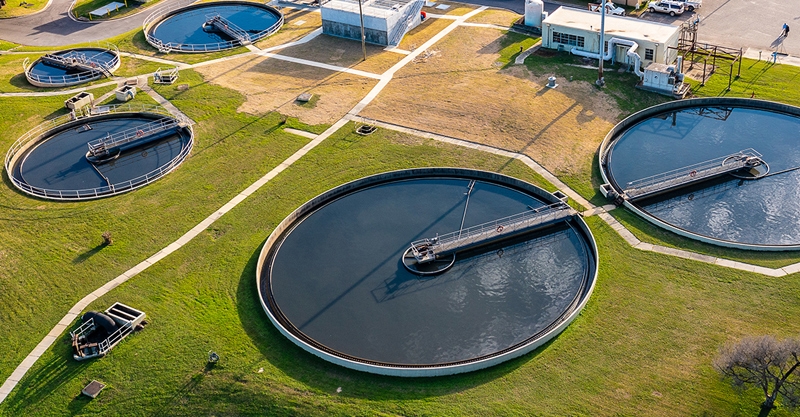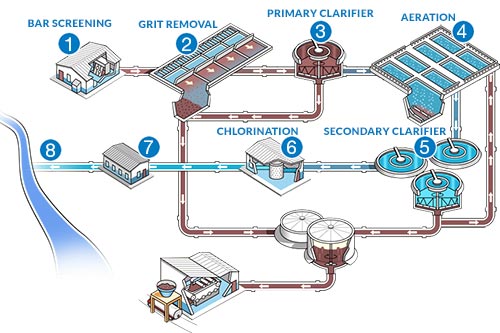The Science Behind Wastewater System
The Science Behind Wastewater System
Blog Article
Discover the Different Kinds of Wastewater System Suitable for Diverse Requirements
The expedition of wastewater systems reveals a spectrum of services customized to fulfill diverse environmental and operational requirements. Centralized therapy systems offer city facilities properly, while decentralized choices give country communities with sustainable alternatives. Understanding these diverse systems not only highlights their individual advantages yet also raises concerns regarding their lasting effects for sustainability and framework strength.
Review of Wastewater Equipment
Wastewater systems play an essential function in handling the water that is utilized and thrown out by houses, industries, and municipalities. These systems are created to accumulate, treat, and discharge wastewater securely, ensuring environmental management and public wellness. The intricacy of wastewater systems occurs from the diverse resources of wastewater, which can include domestic sewer, industrial effluents, and stormwater drainage.
The essential components of wastewater systems consist of collection networks, therapy facilities, and disposal approaches. Collection networks consist of pipelines and pumping stations that carry wastewater from its resource to treatment facilities. Treatment centers then refine the wastewater with physical, chemical, and biological approaches to remove pollutants prior to it is launched back into the setting or recycled for various applications.
The layout and operation of wastewater systems must consider factors such as population density, regulatory needs, and environmental influence. Additionally, advancements in modern technology are resulting in the growth of much more reliable and sustainable wastewater administration techniques. In general, reliable wastewater systems are vital for keeping water quality, preserving water resources, and promoting public wellness in communities internationally.

Centralized Therapy Equipments
Central therapy systems are necessary components of contemporary wastewater management, properly managing large volumes of wastewater generated by industrial tasks and metropolitan populations. These systems generally consist of a network of collection pipelines, treatment plants, and discharge electrical outlets, created to treat wastewater prior to it is released back right into the environment.
Centralized systems are most ideal for densely booming areas where the focus of wastewater necessitates a large response. The main benefit of such systems is their capability to provide uniform therapy requirements, guaranteeing that effluent fulfills regulatory needs before discharge. Furthermore, central treatment facilities usually integrate innovative technologies, such as biological treatment procedures, purification, and disinfection techniques, boosting the quality of treated water.
Functional effectiveness is an additional essential advantage, as economies of range enable minimized per-unit therapy costs compared to decentralized choices - Wastewater System. Nonetheless, centralized systems also deal with obstacles, including the requirement for considerable infrastructure financial investment, potential ecological impacts from big discharge volumes, and vulnerability to system failures that can disrupt service for whole areas.
Decentralized Treatment Alternatives
Decentralized therapy choices provide a flexible and lasting alternative to centralized systems, specifically in rural or less largely inhabited areas. These systems are designed to deal with wastewater near to the source of generation, decreasing the need for considerable piping framework and lessening transportation prices. Typical decentralized innovations include septic tanks, built wetlands, and oxygenated lagoons, each tailored to satisfy particular local problems and treatment requirements.
Septic tanks, for example, are widely used for click to find out more specific homes, effectively dividing solids and liquids while permitting natural purification through the dirt. Built marshes resemble all-natural procedures, supplying reliable treatment with plants and microbial activity, making them an eco-friendly option. Aerated shallows utilize aeration to promote microbial destruction of raw material, ideal for bigger neighborhoods or collections of homes.
Decentralized systems also supply resilience against framework failures usually connected with central systems, permitting communities to preserve wastewater monitoring even during negative problems. They can be integrated with water reuse techniques, advertising sustainability and lowering fresh water demand. Therefore, decentralized treatment choices offer a viable service for diverse wastewater administration requires, boosting environmental management and community health.
Industrial Wastewater Solutions
Efficient monitoring of industrial wastewater is essential for minimizing the environmental impact of making sure and producing procedures conformity with regulative requirements. Industries produce varying sorts of wastewater, typically consisting of harmful chemicals, heavy metals, and organic pollutants, demanding customized therapy options.
One typical method to industrial wastewater management involves pre-treatment procedures, which might include sedimentation, testing, and neutralization to remove large solids and adjust pH degrees. Adhering to pre-treatment, organic treatment techniques such as activated sludge or biofilm activators can effectively minimize natural web content and nutrients. For particular markets, advanced oxidation or membrane layer purification methods may be used to attend to much more complex impurities.

Compliance with local, state, and federal regulations is paramount throughout this process. Regular surveillance and coverage are important to ensure that treatment systems run successfully and fulfill the called for requirements. In summary, tactical planning and robust therapy modern technologies are essential in handling industrial wastewater efficiently, protecting both the environment and public wellness.
Lasting and Ingenious Technologies
Advancements in ingenious and sustainable modern technologies are improving the landscape of wastewater administration, building upon the fundamental methods established in commercial wastewater options. Emerging methods such as membrane layer bioreactors (MBRs) and view publisher site advanced oxidation processes are boosting treatment performance while lessening environmental impact. MBRs incorporate biological therapy and membrane layer filtering, permitting the effective elimination of pollutants and generating high-grade effluent appropriate for numerous reuse applications.
Furthermore, the integration of clever technologies, including Net of Things (IoT) sensors and fabricated knowledge, allows real-time surveillance and optimization of wastewater therapy processes. These innovations promote proactive monitoring, lowering functional costs and energy intake. The adoption of decentralized wastewater treatment systems encourages helpful site communities to manage their sources effectively, promoting sustainability at the regional degree.
Moreover, the use of biotechnological strategies, such as microbial fuel cells, not only treats wastewater yet additionally generates renewable resource. These technologies highlight the shift in the direction of a round economic climate, where wastewater is deemed a resource as opposed to an obligation. By welcoming these lasting and innovative innovations, the wastewater market can significantly add to environmental protection and durability against future difficulties.
Final Thought
In recap, wastewater systems incorporate a range of services customized to fulfill unique needs throughout metropolitan, rural, and commercial contexts. Collectively, these varied systems play a vital function in effective wastewater monitoring and environmental defense.
The complexity of wastewater systems arises from the varied sources of wastewater, which can consist of domestic sewer, industrial effluents, and stormwater runoff.
The essential components of wastewater systems consist of collection networks, treatment centers, and disposal techniques (Wastewater System).Decentralized systems additionally supply resilience versus infrastructure failings usually associated with central systems, allowing neighborhoods to maintain wastewater administration also during damaging conditions.Innovations in innovative and lasting technologies are reshaping the landscape of wastewater monitoring, building upon the fundamental techniques established in commercial wastewater remedies. The adoption of decentralized wastewater therapy systems encourages communities to handle their sources efficiently, advertising sustainability at the neighborhood level
Report this page